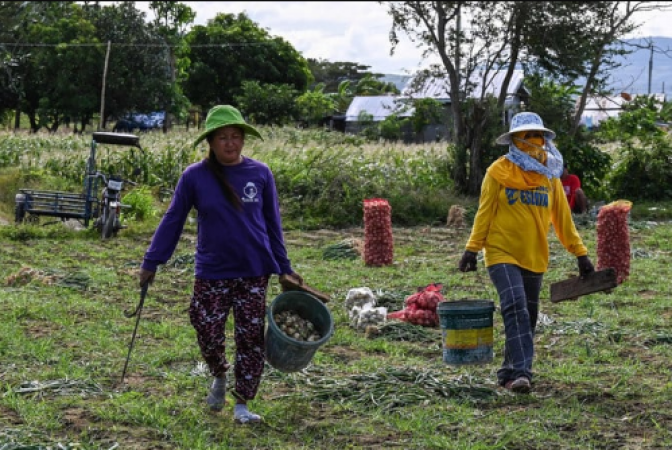
Bonbon: Filipino farmer Luis Angeles rushes to harvest his onions before they are fully grown in order to profit from the country's exorbitant prices for a vegetable that has turned into a luxury good. In Manila supermarkets, onion prices have risen to as much as 800 pesos (nearly $15) per kilogramme in recent months, making them more expensive than chicken or pork. While many families have stopped eating them because they are already dealing with the highest inflation in 14 years, some restaurants have removed the staple ingredient from dishes.
The government has authorised the importation of 21,000 tonnes of onions in order to meet demand and lower retail prices back to 200 pesos, and it is under pressure to take action against merchants who are thought to be hoarding.
Onion farmers like Angeles have been harvesting earlier than usual to take advantage of the windfall as prices remain stubbornly high. As his workers dug small red and white bulbs out of the ground close to the northern town of Bongabon, the nation's self-declared "onion capital," Angeles, 37, remarked that what was happening was historic. It has never happened before for prices to be at this point.
Also Read: CEO of LVMH says Johnny Depp is 'working very well' for Dior Sauvage sales
Angeles received as much as 250 pesos per kilogramme for his crop when he started harvesting last month. When his onions finally made it to the supermarket racks in Manila, the cost had more than doubled and now exceeded the daily minimum wage.
As Candy Roasa, 56, walked through a market in the capital, she saw vendors selling bulbs the size of a small child's fist for as much as 80 pesos each. I told my family, "Let's just smell the onion instead of eating it," she said. The common vegetable has elevated to a symbol of wealth in the nation plagued by poverty as a result of social media memes about onions.
Also Read: Muslims from Indonesia protest Sweden's burning of the Quran
At least one bride substituted expensive bulbs for flowers in her bridal bouquet. On a recent flight from the Middle East, Philippine Airlines crew members were caught attempting to smuggle a few bags of the strong substance through Manila's airport.
It is not the first time that a basic food staple has been in short supply in the Philippines, driving up prices for rice, salt, and sugar. The sector has long been affected by low yields, high costs, inadequate investment in irrigation and machinery, lack of access to cold storage facilities and farm-to-market roads, and crop-destroying typhoons.
Since Russia invaded Ukraine last year, pest outbreaks, as well as rising oil and fertiliser prices, have only made matters worse for farmers.
The country heavily depends on imports to feed its expanding population despite government pledges to increase domestic food production; however, tariffs cause inflation.
President Ferdinand Marcos named himself agriculture secretary to revitalise the nearly moribund sector, which provides about a quarter of the nation's employment but only contributes 10% to GDP.
According to Geny Lapina, a professor of agricultural economics and management at the University of the Philippines, "Our agriculture sector is facing significant challenges. According to official data, each Filipino consumes 2.34 kilogrammes of onions annually, and the nation should theoretically be able to meet the demand.
But because the rain-averse crop can only be planted once a year due to the tropical climate, stocks are depleted or spoil long before the next harvest.An increase in demand for onions was caused by the recent relaxation of Covid-19 restrictions, which opened the door for the return of food-themed festivals and Christmas family gatherings.
Former agriculture secretary under former president Rodrigo Duterte, William Dar, claimed that the shortage could have been avoided if imports had been permitted by the current administration back in August. Dar told the local broadcaster ABS-CBN that the lack of planning was ultimately to blame for this.
Future food security is a growing concern in the Philippines, which is one of the countries most susceptible to the effects of climate change and has a poor nutrition rate. The average farm plot has shrunk from nearly three hectares in the 1960s to about 1.3 hectares today, and the median age of farmers is 57.
Because many farmers are sharecroppers, who do not own the land they cultivate, they are unable to finance the crucial investments in increasing productivity without government assistance.
Also Read: Pope names a native of Chicago in Peru to head the bishops' office
At the University of the Philippines, agricultural economist Salvador Catelo stated that there were "many imposing problems that need to be resolved right away."
According to Catelo, many nations that perform (better) than us in terms of productivity and self-sufficiency lack the wealth of natural resource endowments that we do.
Angeles worries that farm-gate prices could fall to as little as 30 pesos per kilogramme before he finishes his harvest as imported onions flood the nation. He said, "We're just trying to keep our investment alive.